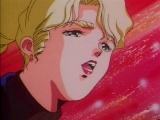

Quick Links:
Super Dimensional Fortress Macross II: Lovers Again, OVA
Macross II was a mistake. Its plot is cliché, the animation is somewhat poor (even for its time), the character designs are nothing out of the ordinary, and it's longer than a film of its nature should be. Oh, and did I mention I loved it? Despite its mountain of flaws, Macross II somehow manages to retain the Macross style. This movie is quality entertainment at its worst.
At the center of Macross II's story is cliché #1, the love triangle. Reporter Hibiki Kanzaki has a habit of using tabloid tactics to get the big stories. In one of his less honorable reporting jobs, he films Lt. Sylvie Gena (pilot in the U.N. space force) and her superior officer as they walk out of a hotel room. From this encounter is born cliché #2, the opposites attract phenomenon. The matter Sylvie discussed with her officer concerned the defense Earth used against invasions, and how she believed they rely on it too much. Her fears were realized when Earth came under attack by the Marduk, a race of warmongers who've brainwashed some Zentraedi (using music) to fight for them against the despicable Earth trash (NOTE: the Zentraedi are a race who look like humans but larger. They appear in previous Macross works). The Marduk use 'emulators' to control the Zentraedi. Emulators are hot women who sing, to put it simply. Their songs are only used for war, as war and conquest is the central purpose of their entire culture. Enter member 3 of the love triangle, an emulator named Ishtar. Hibiki meets Ishtar through a chance happening in the middle of a space battle that his news organization is covering, and he takes her home to show her a bit of what Earth has to offer.
The main story of Macross II is all about culture. The Marduk culture centers around war, but there is a prophecy concerning the Ship of Alus, which will bring peace to the Marduk and save their society from itself. In her time on Earth, Ishtar learns about what it's like to live in a peaceful society. Whereas their music is used for war, she learns of the many other uses for music. She also believes that the fabled ship of Alus is the Macross itself. Despite the fact that the plot devices are just several clichés rolled up into one, the story does not disappoint. There is nothing breathtaking, surprising, or profound about it; however, it is successful in carrying on the Macross tradition of love, music, and lots of white dots on the screen. It's an entertaining story, one worth experiencing.
The music for Macross II is downright excellent. Music has always been an important, integral part of the Macross stories, and this story is no different. It sports a nice blend of suspense, love, pop, and rock. The song "Moichido, Love You" turned an otherwise bland scene into something magical. Several other good songs help lift the film to above-average status. Without the good music, the film would have nearly nothing to speak for.
The animation and character designs for Macross II are nothing to write home about. Ishtar is somewhat elaborate in design, but her voice is what really defines her character. There are some technical problems apparent in the animation. One such problem is that lip movements do match the soundtrack in some places but not in others. The movie isn't badly animated, but it certainly could have been better.
Overall, there are a lot of things to like about Macross II. Its technical aspects could have been improved, but the movie has it where it counts, in entertainment value and music. It's one of the most disappointing good movies out there, but it is good nonetheless.
Distributor: Manga Creator: Big West Released: 1993
Plot: C Character Design: B- Animation Quality: C- Music: A+ Overall: B



